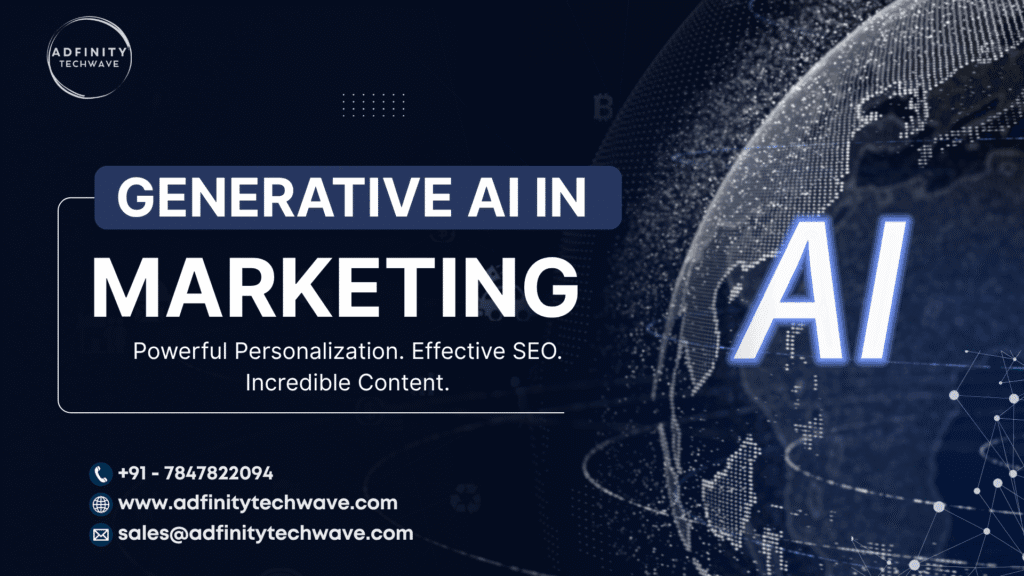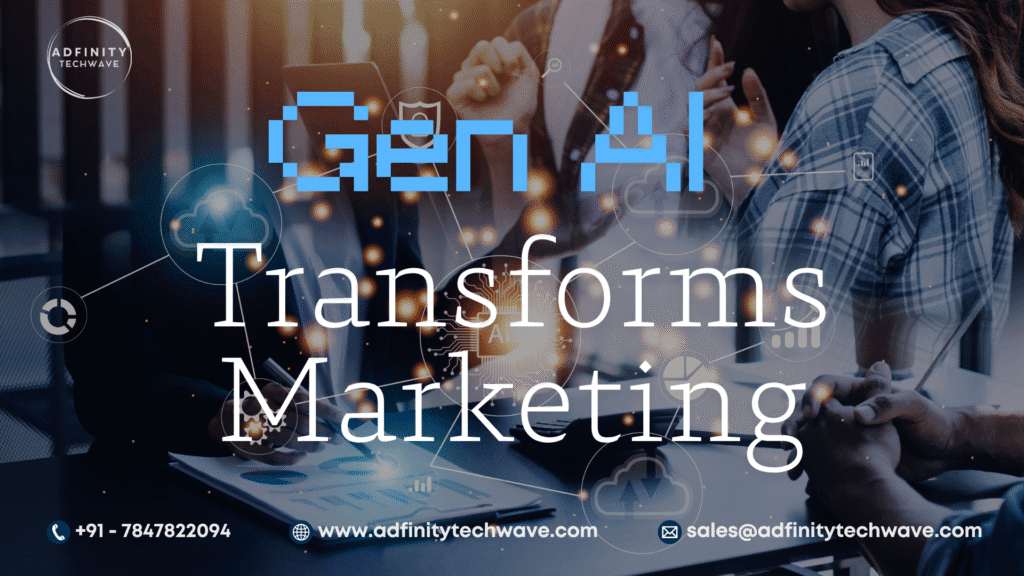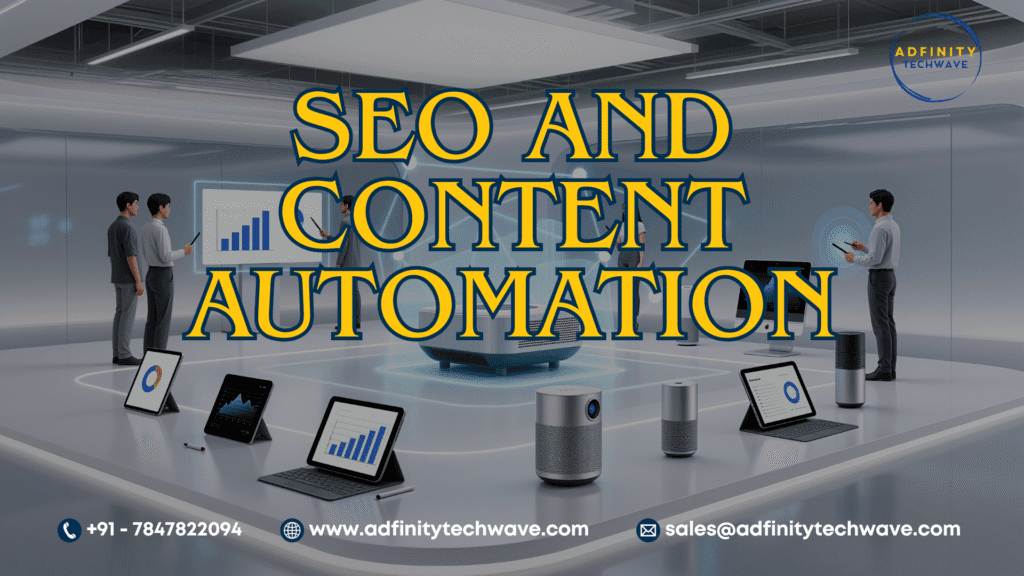
The Seismic Shift: How Generative AI in Marketing Creates an Unstoppable Competitive Edge
The marketing landscape, once defined by static content calendars and broad-brush segmentation, is undergoing a profound, irreversible transformation. At the heart of this revolution is Generative AI in Marketing. This is not just a technological upgrade; it is a fundamental shift in how brands interact, create, and strategize. For marketers navigating the complexities of 2025 and beyond, understanding the mechanics, implications, and strategic deployment of Generative AI (GenAI) is not optional—it is the difference between leading the market and being left behind.
In an age where consumer attention is fragmented and the demand for truly personalized experiences is at an all-time high, GenAI offers the super-power to meet this challenge at scale. It moves beyond traditional automation to enable creation, turning data into dynamic, high-quality, and hyper-relevant content in real-time. This in-depth guide will dissect the essence of Generative AI, explore its massive transformative impact across every marketing function, and provide a strategic roadmap for adopting this pivotal technology.
Table of Contents
1. Decoding Generative AI: What Exactly Is It?
Generative AI is a category of artificial intelligence systems designed to create new and original content. Unlike analytical AI, which is used to process existing data (like classifying an image or predicting a trend), Generative AI systems produce novel outputs, including text, images, video, audio, and even synthetic datasets, often based on simple natural language prompts.
Generative AI vs. Traditional AI
The key distinction lies in the output:
| Feature | Traditional (Discriminative) AI | Generative AI |
| Primary Function | Classification, Prediction, Analysis | Creation, Synthesis, Production |
| Core Question | What is this? (e.g., Is this email spam?) | What can I make? (e.g., Write a promotional email.) |
| Output | A label, a score, a prediction (e.g., ‘Spam,’ ‘75% likelihood’) | New, original data (e.g., A blog post, an image, a video script) |
| Marketing Use | Customer segmentation, predictive analytics, lead scoring. | AI content creation, hyper-personalized ad copy, dynamic creative. |
The Technology Powering the Revolution: LLMs, GANs, and Transformers
The power of Generative AI in Marketing stems from several complex but crucial technological breakthroughs:
- Large Language Models (LLMs): These are the backbone of text-based GenAI (like GPT-4 and Claude). Trained on colossal datasets of internet text, LLMs learn to predict the most statistically probable next word, enabling them to generate coherent, contextually relevant, and human-like prose, from a simple tweet to a 5,000-word e-book.
- Generative Adversarial Networks (GANs): Used primarily for image and video creation, a GAN consists of two competing neural networks: a Generator (which creates the content) and a Discriminator (which tries to determine if the content is real or fake). This adversarial process constantly refines the output, leading to incredibly realistic images and digital art.
- Transformer Architecture: This architecture, first introduced by Google, is the foundational innovation behind LLMs. It uses a mechanism called “self-attention” which allows the model to weigh the importance of different words in a sentence, drastically improving context understanding and enabling the creation of models with billions of parameters.
2. The Core of Transformation: Generative AI’s Impact on Marketing
Generative AI is systematically overhauling the three pillars of modern marketing: Content, Customer Experience, and Strategy. Its influence is so pervasive that it is fundamentally changing the role of the marketer itself.
Hyper-Personalization and the One-to-One Experience
The holy grail of marketing has always been the ability to speak to a customer as an individual, not as part of a segment. Traditional methods struggled to scale this, often relying on basic variables like first name and last purchase.
Generative AI in Marketing shatters this barrier:
- Dynamic Creative Optimization (DCO): GenAI tools can instantly generate hundreds of variations of an ad creative (image, headline, call-to-action) in real-time, testing and deploying the most effective combination for an individual user based on their historical behavior, browsing context, and even the weather. A single campaign can now run a million personalized campaigns simultaneously.
- Tailored Customer Journeys: An LLM can be trained on a brand’s entire knowledge base and customer data to craft a personalized email sequence, chatbot response, or website pop-up that reflects the customer’s exact journey stage, emotional state (sentiment analysis), and purchase intent. This is the ultimate expression of hyper-personalization.
- Virtual Brand Ambassadors: GenAI enables the creation of lifelike, conversational AI agents that provide 24/7 customer support, product recommendations, and guided sales journeys, maintaining a consistent, brand-appropriate voice across all touchpoints.
The Content Creation Multiplier: Scale, Speed, and Efficiency
The demand for fresh, engaging content is relentless, far outpacing the capacity of human teams alone. GenAI acts as a massive content creation multiplier.
- Drafting and Ideation: Marketers no longer start with a blank page. GenAI can instantly generate comprehensive first drafts for blog posts, social media captions, white papers, and video scripts. This frees up human writers to focus on editing, fact-checking, and adding the crucial elements of originality, Experience, and Authority (the E-E-A-T principle).
- Localization and Transcreation: GenAI can rapidly translate and localize marketing materials for dozens of global markets, not just changing the language but also adapting the tone, cultural references, and imagery (transcreation) to resonate deeply with local audiences.
- Asset Generation: Tools like Midjourney and DALL-E have democratized graphic design. Marketers can now generate high-quality, unique images and illustrations for social media, display ads, and blog banners in seconds, drastically reducing the cost and time of asset production.
Redefining SEO: The Dawn of Generative Engine Optimization (GEO)
The most profound, yet often misunderstood, impact of GenAI is on Search Engine Optimization (SEO). The introduction of AI-powered search results (like Google’s AI Overviews) has given rise to Generative Engine Optimization (GEO).
GEO is the practice of optimizing content not just for search engine algorithms, but for the Large Language Models (LLMs) and AI chatbots that synthesize information to deliver direct answers.
This shift means:
- Focus on Facts and Citations: AI overviews are built on factual accuracy. Content that is well-sourced, current, and clearly structured to answer specific questions is more likely to be cited by the AI.
- Schema Markup is King: Structured data (Schema markup) provides clear, explicit context to AI models, telling them exactly what the content is about (e.g., “This is an FAQ,” “This is a product review”). This clarity is vital for AI systems that prioritize informational precision.
- The Rise of Conversational Content: As search becomes more conversational (long-tail, natural language questions), content must be structured to directly answer these queries. This reinforces the importance of using question-based headings and comprehensive FAQ sections.
The strategic deployment of Generative AI in Marketing fundamentally alters content distribution, placing the emphasis on high-quality, authoritative information that feeds both the traditional SERP and the new AI-powered answer engines.
Marketing Automation: Moving Beyond Simple Rules
Traditional automation follows ‘if/then’ rules. Generative AI enables intelligent automation.
- Autonomous Campaign Management: GenAI can monitor a campaign’s performance in real-time and make autonomous adjustments—changing a headline, shifting budget allocation, or even generating an entirely new set of keywords—without human intervention, leading to immediate efficiency gains and improved ROI.
- Intelligent Reporting and Analysis: Instead of dumping raw data, GenAI can analyze complex datasets and summarize key insights, risks, and recommended actions in plain, natural language for executives. This drastically speeds up the decision-making process.

3. Generative AI Use Cases Across the Marketing Funnel
To truly grasp the power of GenAI, marketers must see how it integrates into their day-to-day operations across the entire customer journey.
| Funnel Stage | Traditional Marketing Tactic | Generative AI in Marketing Application |
| Top-of-Funnel (Awareness) | Mass-market blog posts, broad display ads. | Content Ideation & SEO: Generating long-tail keyword ideas and blog outlines optimized for GEO; creating 100 display ad variations to target micro-audiences. |
| Mid-Funnel (Consideration) | Generic nurturing email sequences, standard white papers. | Personalized Nurturing: Crafting unique, context-aware email subject lines and body copy for each lead based on their specific content consumption history. |
| Bottom-of-Funnel (Conversion) | Static landing pages, standard product descriptions. | Dynamic Landing Pages (DLP): Generating real-time, personalized value propositions and social proof (e.g., reviews summary) based on the visitor’s geographic location and referral source. |
| Loyalty & Advocacy | Standardized customer service and follow-up emails. | AI Customer Support: Deploying sophisticated LLMs in Marketing to handle complex service issues and proactively suggest new products or loyalty rewards tailored to the individual. |
Deep Dive: Product Description Automation
For e-commerce, GenAI is a game-changer. Imagine a retailer with 50,000 products. Writing unique, SEO-friendly descriptions for all of them is impossible. GenAI can:
- Take key product data (material, color, dimensions).
- Generate five different descriptions: one concise, one storytelling-focused, one technical, one optimized for Amazon, and one for a social media caption.
- Ensure each one is optimized for the appropriate set of long-tail keywords.
This capacity for scale accelerates time-to-market for new products and ensures comprehensive SEO coverage.
4. Strategic Deep Dive: Generative AI and the Future of Search
The rise of Generative AI is inextricably linked to the evolution of search, creating a new mandate for marketers focused on visibility and trust.
The AI Overviews Challenge and Opportunity
Google, Microsoft, and other search providers are increasingly synthesizing answers directly on the Search Engine Results Page (SERP) using their own LLMs, often in a section called “AI Overviews” or similar.
- The Challenge: Users may get the answer they need without clicking through to your site, potentially reducing organic traffic for purely informational queries.
- The Opportunity: For content to be included in an AI Overview, it must be recognized as the most authoritative, reliable, and trustworthy source for that specific piece of information. Marketers must shift their focus from ranking the page to becoming the cited source within the AI answer.
Optimizing for Conversational AI: Structured Data and E-E-A-T
To succeed in the age of GEO, your content strategy must embrace principles that appeal directly to the AI models:
- Clarity and Conciseness: AI models excel at extracting precise facts. Ensure your content includes clear definitions, structured lists, tables, and short paragraphs that explicitly answer user questions. Use Rank Math’s Schema Generator to explicitly tag FAQs, How-To guides, and specific facts, making it easier for the LLM to identify and pull accurate data.
- The E-E-A-T Principle (Experience, Expertise, Authoritativeness, Trustworthiness): GenAI models are trained to prioritize high-quality, trustworthy sources. Your content must demonstrate human Experience (first-hand account), Expertise (knowledge on the subject), Authoritativeness (reputation), and Trustworthiness (accuracy and citations).
- Long-Tail and Conversational Keywords: The conversational nature of AI chat and voice search means that long-tail, question-based keywords (e.g., “What is the best way to use Generative AI for email subject lines?”) will become more valuable than short, generic terms. Rank Math’s Content AI feature can be invaluable here, suggesting semantically related keywords and question structures used by top-ranking content.
The ultimate SEO strategy for the Generative AI era is to create content that is so good, so comprehensive, and so trustworthy that the AI has no choice but to cite it as the foundational source.

5. Navigating the Ethical Landscape and Challenges
While the potential of Generative AI in Marketing is immense, its adoption comes with a critical set of ethical and operational challenges that must be addressed proactively. Ignoring these risks can lead to significant brand damage and legal liability.
Data Security, Bias, and ‘Hallucinations’
- Data and Privacy: GenAI models require massive amounts of data for training. When using proprietary or custom-trained models, organizations must ensure that sensitive customer data (Personally Identifiable Information – PII) is fully anonymized and segregated to comply with regulations like GDPR and CCPA.
- AI Bias: Generative models are only as unbiased as the data they are trained on. If a model is trained on a dataset that over-represents one demographic or perpetuates stereotypes, its output (e.g., a generated ad image or a customer service response) can exhibit and amplify that bias, leading to offensive or exclusionary marketing content.
- Mitigation: Implement rigorous auditing processes and ensure the training data is diverse, fair, and continually monitored for potential bias.
- Hallucinations and Accuracy: Generative AI is known to “hallucinate”—to confidently present false or misleading information as fact. In marketing, this could lead to publishing inaccurate product specifications, fabricating testimonials, or citing non-existent research.
- Mitigation: Zero tolerance for unedited GenAI output. All marketing content—especially claims and facts—must be subjected to a mandatory human fact-checking layer before publication.
The Critical Role of the Human-in-the-Loop
The notion that Generative AI will eliminate marketing jobs is simplistic. Instead, it is transforming them. The most successful Generative AI in Marketing implementations will place a skilled human at the center of the process.
- The Prompt Engineer: Marketers are becoming “prompt engineers,” mastering the art of instructing the AI model to produce the desired output. This requires deep strategic thinking, brand knowledge, and an understanding of the target audience.
- The Editor and Curator: The human role shifts from content creator to content refiner, validator, and curator. The marketer is responsible for infusing the AI-generated draft with the unique brand voice, emotional nuance, and essential E-E-A-T that only a human subject matter expert can provide.
- Legal and Ethical Oversight: A human must be the final authority, ensuring all generated content is legally compliant, ethically sound, and aligned with core brand values.
Generative AI is a co-pilot, not an autopilot. Its true power is realized in collaboration with human creativity and judgment.
6. Building Your Generative AI Marketing Strategy
Adopting Generative AI in Marketing requires a structured, strategic approach, not a scattergun adoption of every new tool.
A Phased Implementation Plan
- Phase 1: Experimentation and Learning (The Quick Wins):
- Focus: Low-risk, high-volume tasks.
- Actions: Implement GenAI for first-draft content creation (blog outlines, email subject lines, social media posts). Use image generators for low-stakes internal or social graphics.
- Metric: Time saved on content ideation and drafting (e.g., 50% faster first draft creation).
- Phase 2: Integration and Optimization (The Core Transformation):
- Focus: Integrating LLMs in Marketing workflows (e.g., CRM, CMS) and optimizing for efficiency.
- Actions: Deploy GenAI for dynamic creative optimization (DCO) in ad campaigns; integrate GenAI-powered chatbots for Tier 1 customer support; use AI to generate multiple versions of landing page copy for A/B testing.
- Metric: Increase in conversion rates, lower customer service handling time.
- Phase 3: Transformation and Innovation (The Competitive Edge):
- Focus: Redefining core strategic functions and pursuing cutting-edge capabilities.
- Actions: Implement true hyper-personalization across all channels; use GenAI for predictive journey mapping; focus content strategy entirely on GEO principles, making the brand a dominant source for AI overviews.
- Metric: Significant ROI improvement, market share gains, and measurable reduction in cost-per-lead.
The Future-Proof Marketing Team: New Roles and Skillsets
The rise of GenAI demands that marketing teams upskill and redefine roles:
- The Data Translator: A specialist who bridges the gap between raw data (customer behavior, campaign performance) and the AI model, ensuring the AI receives clean, relevant inputs.
- The AI Ethicist/Auditor: Responsible for monitoring AI output for bias, brand safety, and compliance with ethical guidelines. They are the “Human-in-the-Loop” gatekeeper.
- The Prompt Engineer/Content Strategist: The new creative lead. They design the sophisticated prompts that guide the AI, edit the resulting content, and ensure the final product maintains a unique brand voice and delivers true E-E-A-T value.
Marketing success in this new era hinges not on replacing people with AI, but on empowering people with AI.
7. Conclusion: The Marketer as a Prompt Engineer
Generative AI in Marketing isn’t just another innovation—it’s the new foundation for how brands ideate, create, and connect with their audiences. The marketers who will lead in 2025 and beyond are those who don’t fear automation but understand how to collaborate with it.
The future belongs to the AI-empowered marketer—one who combines human insight with machine precision. Instead of simply writing copy or running campaigns, marketers now design systems of intelligence: prompt frameworks, data flows, and creative engines that can generate dynamic, hyper-personalized experiences at scale.
This shift doesn’t replace human creativity—it amplifies it. Generative AI delivers the scale and speed, while humans bring emotional depth, storytelling, and ethical clarity. Together, they form the new creative core of digital marketing.
At Adfinity Techwave, we believe this era marks the rise of augmented marketing—where AI becomes a true co-creator in building brand stories that engage, convert, and endure. Our role as a digital growth partner is to help businesses harness this transformation strategically: implementing Generative AI systems that blend automation with authenticity, efficiency with empathy, and data with design.
The revolution is already here. The only question is: will your brand be adapting to it—or defining it?
Generative AI in Marketing: FAQs
What is the main difference between Generative AI and traditional AI in a marketing context?
Traditional (discriminative) AI analyzes existing data to make a prediction or classification (e.g., scoring a lead). Generative AI in Marketing creates new content or output (e.g., writing a unique ad copy, generating a new image) based on patterns it learned from data. The key distinction is creation vs. analysis.
What is Generative Engine Optimization (GEO)?
GEO is the strategy of optimizing content to be easily understood, retrieved, and cited by Generative AI systems, such as Large Language Models (LLMs) and AI Overviews in search engines. It emphasizes structure, clarity, factual accuracy, and strong E-E-A-T signals.
How can Generative AI help with hyper-personalization?
GenAI analyzes vast customer data sets in real-time to create completely unique content for an individual, far beyond simple name changes. This includes dynamic ad creatives, personalized email sequences, and real-time product recommendations that reflect a person’s exact browsing history and predicted purchase intent.
Is it safe to publish AI-generated content without editing?
Absolutely not. Generative AI models can “hallucinate” (confidently state false information) or produce content that lacks a unique brand voice or required E-E-A-T. A human-in-the-loop must always review, fact-check, and refine AI-generated content for accuracy, brand alignment, and ethical compliance.
What are the biggest ethical concerns about using Generative AI in marketing?
The primary concerns include the potential for AI models to perpetuate and amplify bias in marketing materials, the risk of publishing inaccurate or hallucinated information, and critical issues around data privacy and compliance when training models on sensitive customer data.
🚀 Ready to Transform Your Marketing with Generative AI?
Let’s build your next growth chapter together.
👉 Contact Adfinity Techwave to explore how Generative AI can redefine your brand’s visibility, performance, and personalization strategy.
- The Ultimate Generative AI in Marketing Revolution: A 2025 Deep Dive into Powerful Personalization, Effective SEO, and Content Growth
- The Ultimate Guide to Choosing the Right Web Hosting Plan
- Social Media Marketing and User Satisfaction Strategies for Success
- SEO for WordPress Websites 2025 – A Proven Beginner’s Guide to Rank Faster
- Logo Design and Branding : The Secret to Building Iconic Brands That Last

